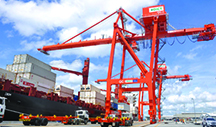 Davao International Container Terminal’s (DITC) throughput in the first five months of the year has surpassed volume recorded in the eight months since the facility opened in May 2013.
Davao International Container Terminal’s (DITC) throughput in the first five months of the year has surpassed volume recorded in the eight months since the facility opened in May 2013.
From January to May, DICT handled 70,962 twenty-foot equivalent units (TEU) and serviced 68 vessels. This compares with 18,287 TEUs and 39 vessels recorded from May to December 2013.
The 2014 target volume of 240,000 TEUs “is well within reach,” Bonifacio Licayan, assistant general manager of DICT port operator San Vicente Terminal and Brokerage Services, Inc. (SVTBSI), told PortCalls in an email. The target, he noted, represents 85% of the terminal’s annual capacity of 345,000 TEUs.
Located in Panabo City, Davao del Norte, the eight-hectare DICT is situated within major agricultural plantations in the area, catering heavily to the reefer trade.
APL, Pacific International Lines and the Advance Container Lines and Regional Container Lines alliance currently make a total of three shipcalls per week at the terminal.
The number of calls may double to six per week by end of June or early July, according to Licayan.
He noted more exporters and importers are now using DICT, having found the “efficiency of DICT to their liking and advantage, and their cost of doing business now is even lower compared to in Davao.”
“DICT, with its efficient port operations and world-class port facility and equipment, has rendered the fresh produce of Mindanao very competitive in the global market,” he said.
Bananas, the region’s main export product, are shipped to such markets as China, Japan, Korea and the Middle East. The Philippines is the world’s third-largest exporter of the fruit.
Licayan said the terminal has “witnessed the influx of small banana growers doing their consolidation of fruits in our consolidation area and exporting via DICT.”
He noted that while the banana industry still has challenges “due to less than ideal weather conditions,” he said the sector is hoping for better export volumes in 2014, “even if only by a modest amount.”
It may be recalled that the banana industry was devastated by Typhoon Bopha (local name Pablo) in late 2012. The strongest tropical cyclone to ever hit Mindanao destroyed vast swathes of banana crop causing losses of at least $300 million.
Cargo-handling muscle
As it prepares to handle greater cargo volume, DICT is beefing up cargo-handling equipment with orders of two additional reach stackers and two empty container handlers.
It is also acquiring four more terminal tractors with bombcarts to increase such fleet to 14.
In order to better serve the reefer trade, an additional 360 reefer plugs will be installed and will be fully operational by August, increasing the port’s plug-in capacity to 1,080 reefer plugs.
The port’s 250-meter berth has an average draft of 15.5 meters, which allows it to accommodate large Panamax vessels.
The port can do 25 to 28 moves per hour per crane “assuming the availability of all containers for loading, timely submission of loading list, and accuracy of EDIs coming from previous ports”, said Licayan.
Meanwhile, DICT’s empty container depot (ECD), located about 400 meters from the port, is now in partial operation.
“We have started moving all empty dry containers to the ECD. By August this year, all the empty reefer containers and the attendant pre-trip inspection, washing, and maintenance and repair services will totally relocate to the ECD,” Licayan said.
DICT was established by SVTBSI, a member of the ANFLOCOR Group of Companies, in partnership with two of the country’s top Cavendish banana exporters — Tagum Agricultural Development Co., Inc. and Dole-Stanfilco.
DICT has been in full commercial operation since January 2014 although it has yet to be formally launched. – Roumina M. Pablo




